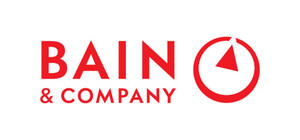- Digital engineering is front and center of companies' reinvented business models
- Tech layoffs could fill talent gap in ER&D companies
BOSTON and LONDON and SINGAPORE, April 12, 2023 /PRNewswire/ -- Businesses' global investments in engineering, and on research and development in the engineering (ER&D) sector, are set to rise strongly over the next five years, expanding at a double-digit compound annual growth rate (CAGR) of 10% up to 2026 despite currently uncertain economic conditions, Bain & Company's latest research reveals.
A ramped-up pace of investment by industry in digital engineering and related capabilities, as businesses accelerate spending on digitalization, is central to the strong projected trend in overall investment. Digital investments are set to register a CAGR of 19% from 2022 to 2026 – almost double the overall investment growth rate for ER&D spending, Bain's survey of more than 500 senior executives globally shows.
Bain & Company's findings, in its latest Global Engineering and R&D report, reveal that majority of the senior executives surveyed plan to increase ER&D spending despite present economic upsets and turbulence. Industries still planning to increase such spending include automotive and mobility, aerospace and defense, medical devices, advanced manufacturing and services, energy and natural resources and telecommunications.
"Companies today view ER&D as a strategic capability that will determine their future success and shape new business models. Investments in ER&D not only improve products but also increasingly reinvent or disrupt parts of the business," said Zurich-based partner Daniel Suter.
ER&D is defined as the wide array of activities aimed at developing new products and services and improving existing ones. Digital engineering refers to the discipline of developing new, connected, and digitally enabled products and services using technologies such as artificial intelligence (AI), machine learning, and cloud computing.
As spending soars, leadership teams are redoubling their efforts to achieve a solid return which is made more challenging in a recession.
During past recessions such as the 2008–2009 global financial crisis, ER&D spending was more resilient than GDP growth, according to Bain's research. And between 2014 and 2021, global ER&D spending grew nearly four times faster than GDP. One explanation is that a large body of ER&D work typically spans longer time horizons and thus tends to be less fungible than other types of spending.
"Investing in ER&D during a downturn can help companies pull ahead in the innovation race. The recent large-scale layoffs in the technology sector also offer ER&D companies an opportunity to hire much-needed talent," said Suter.
"The most successful companies use recession years to out-innovate competitors by acquiring companies at lower multiples, poaching critical talent, and investing in intellectual property and R&D."
Bridging the talent gap in ER&D
Bain's report showed that 73% of ER&D companies report talent gaps, and that divide will widen as baby boomers retire more quickly than new graduates fill their shoes, and mid-career engineers transition to non-engineering roles. Globally, the percentage of engineers quitting their jobs at engineering companies has risen to between 16% and 17%, up by nearly 2 percentage points from three years ago.
"The shortage of engineering talent is affecting all geographies and is likely to continue throughout the coming decade. Leading companies are realizing that in a tight talent market, it is as important to improve the attractiveness of engineering roles as it is to scour the market for new pockets of labor," added Suter.
Using digital ER&D to create value and improve outcomes for customers
Historically, companies have viewed ER&D as a core function to make products better and cheaper. Today, an emerging group of leaders are putting ER&D and new technologies at the center of their businesses to innovate and reinvent business models. They are moving into outcome-based solutions that allow customers to pay based on agreed results, such as machine uptime.
"The risk of technology-based disruption adds urgency to the search for new sources of value creation. Companies in ER&D-heavy industries that do not invest and innovate to improve the customer experience may find themselves rapidly sidelined by nimble rivals," said Suter.
Nearly three-quarters of chief technology officers surveyed by Bain said that shortening time to market is a top priority for engineering departments, while 70% say incorporating novel technologies into products and services is a key priority.
Companies transitioning to new business models have incorporated strategies such as investment in technology e.g. a digital twin to catch errors and reduce time to market; expanding the engineering team's scope across product/ solution lifecycle; cross-functional teams that provide access to strategic assets such as technology expertise to all departments; shift from cyclical product development towards continuous technology development; and an ecosystem of partners to fuel innovation and broaden their capabilities.
Top three outsourcing sectors - industrial manufacturing, automotive, medical devices
Signaling a strategic shift, 60% of companies plan to increase ER&D outsourcing over the next three years, according to Bain's survey. Historically, large companies have outsourced about 18% of ER&D work by value. That level is far lower than that in the IT services sector, which went through a similar transformation in the 2000s and now outsources 46% of activities.
In addition to accelerating innovation, outsourcing and offshoring also help leadership teams address chronic talent shortages and mounting cost pressure. Over 80% of the senior executives surveyed report talent gaps in areas requiring digital expertise, including data engineering, data analytics, artificial intelligence, cybersecurity, IoT, and connectivity, but also in other crucial areas such as systems engineering. Underscoring that trend, 73% of respondents said industry or technology expertise is the most important factor in selecting an outsourcing partner. That compares with 59% of respondents who cited cost as the No. 1 factor.
ER&D outsourcing is growing in all areas of expertise covered by the survey, and the type of outsourced work is changing. Companies are also seeking new capabilities from service providers. In the past, demand focused primarily on mechanical and core engineering skills. Today, executives plan in invest significantly in digital engineering capabilities, particularly cybersecurity, IoT, cloud, embedded software and data engineering and analytics.
The use of ER&D service providers varies by industry. Bain's research showed the sectors most inclined to increase outsourcing in the next three years are industrial manufacturing, automotive, medical devices, energy, and aerospace and defense.
Finally, the types of projects are changing. Historically, large research organizations have mainly outsourced activities like testing, validation, and compliance while keeping core systems and products in-house. Now, the same companies are outsourcing a wider scope of activities, such as the end-to-end design of products or the development of key components such as combustion engines, traditionally a vital capability of automotive OEMs.
Note: Investments in ER&D include expenses for research, product, engineering, content, technology, and software development, product testing, regulatory and clinical trials, and other ER&D related costs.
Editor's Note: For more information or interview requests please contact:
Bain & Company
Americas
Katie Ware, tel: +1 646 562 8107, email: [email protected]
Asia Pacific
Ann Lee, tel: +65 6228 2960, email: [email protected]
Europe, Middle East and Africa
Gary Duncan, tel: +44 7788 163791, email: [email protected]
About Bain & Company
Bain & Company is a global consultancy that helps the world's most ambitious change makers define the future.
Across 65 cities in 40 countries, we work alongside our clients as one team with a shared ambition to achieve extraordinary results, outperform the competition, and redefine industries. We complement our tailored, integrated expertise with a vibrant ecosystem of digital innovators to deliver better, faster, and more enduring outcomes. Our 10-year commitment to invest more than $1 billion in pro bono services brings our talent, expertise, and insight to organizations tackling today's urgent challenges in education, racial equity, social justice, economic development, and the environment. We earned a gold rating from EcoVadis, the leading platform for environmental, social, and ethical performance ratings for global supply chains, putting us in the top 2% of all companies. Since our founding in 1973, we have measured our success by the success of our clients, and we proudly maintain the highest level of client advocacy in the industry.
SOURCE Bain & Company

WANT YOUR COMPANY'S NEWS FEATURED ON PRNEWSWIRE.COM?
Newsrooms &
Influencers
Digital Media
Outlets
Journalists
Opted In



Share this article